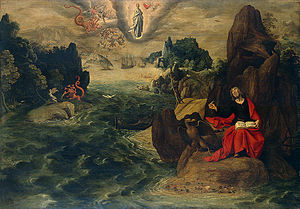
Fra Bartolomeo or Bartolommeo, also known as Bartolommeo di Pagholo, Bartolommeo di San Marco, Paolo di Jacopo del Fattorino, and his original nickname Baccio della Porta, was an Italian Renaissance painter of religious subjects. He spent all his career in Florence until his mid-forties, when he travelled to work in various cities, as far south as Rome. He trained with Cosimo Rosselli and in the 1490s fell under the influence of Savonarola, which led him to become a Dominican friar in 1500, renouncing painting for several years. Typically his paintings are of static groups of figures in subjects such as the Virgin and Child with Saints.

John the Evangelist is the name traditionally given to the author of the Gospel of John. Christians have traditionally identified him with John the Apostle, John of Patmos, and John the Presbyter, although this has been disputed by most modern scholars.

John the Apostle or Saint John the Beloved was one of the Twelve Apostles of Jesus according to the New Testament. Generally listed as the youngest apostle, he was the son of Zebedee and Salome. His brother James was another of the Twelve Apostles. The Church Fathers identify him as John the Evangelist, John of Patmos, John the Elder, and the Beloved Disciple, and testify that he outlived the remaining apostles and was the only one to die of natural causes, although modern scholars are divided on the veracity of these claims.

Hieronymus Bosch was a Dutch/Netherlandish painter from Brabant. He is one of the most notable representatives of the Early Netherlandish painting school. His work, generally oil on oak wood, mainly contains fantastic illustrations of religious concepts and narratives. Within his lifetime his work was collected in the Netherlands, Austria, and Spain, and widely copied, especially his macabre and nightmarish depictions of hell.
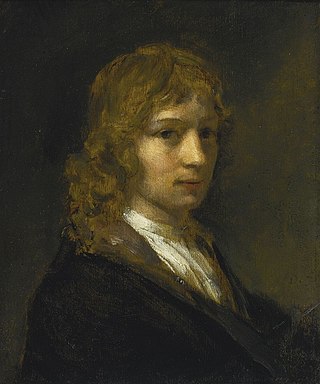
Willem Drost was a Dutch Golden Age painter and printmaker of history paintings and portraits.
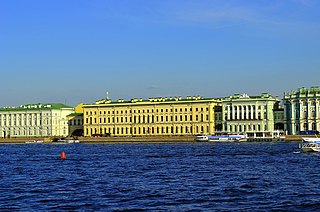
The State Hermitage Museum is a museum of art and culture in Saint Petersburg, Russia. It was founded in 1764 when Empress Catherine the Great acquired a collection of paintings from the Berlin merchant Johann Ernst Gotzkowsky. The museum celebrates the anniversary of its founding each year on 7 December, Saint Catherine's Day. It has been open to the public since 1852. The Art Newspaper ranked the museum 10th in their list of the most visited art museums, with 2,812,913 visitors in 2022.

Bartolomé Esteban Murillo was a Spanish Baroque painter. Although he is best known for his religious works, Murillo also produced a considerable number of paintings of contemporary women and children. These lively realistic portraits of flower girls, street urchins, and beggars constitute an extensive and appealing record of the everyday life of his times. He also painted two self-portraits, one in the Frick Collection portraying him in his 30s, and one in London's National Gallery portraying him about 20 years later. In 2017–18, the two museums held an exhibition of them.

Guido Reni was an Italian painter of the Baroque period, although his works showed a classical manner, similar to Simon Vouet, Nicolas Poussin, and Philippe de Champaigne. He painted primarily religious works, but also mythological and allegorical subjects. Active in Rome, Naples, and his native Bologna, he became the dominant figure in the Bolognese School that emerged under the influence of the Carracci.

Abraham Bloemaert was a Dutch painter and printmaker who used etching and engraving. He initially worked in the style of the "Haarlem Mannerists", but by the beginning of the 17th-century altered his style in line with the new Baroque style that was then developing. He mostly painted history subjects and some landscapes. He was an important teacher, who trained most of the Utrecht Caravaggisti.
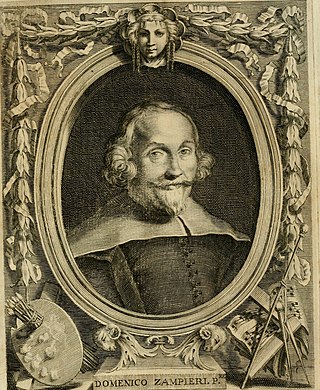
Domenico Zampieri, known by the diminutive Domenichino after his shortness, was an Italian Baroque painter of the Bolognese School of painters.

John of Patmos is the name traditionally given to the author of the Book of Revelation. Revelation 1:9 states that John was on Patmos, a Greek island where, according to most biblical historians, he was exiled as a result of anti-Christian persecution under the Roman emperor Domitian.

Picasso's African Period, which lasted from 1906 to 1909, was the period when Pablo Picasso painted in a style which was strongly influenced by African sculpture, particularly traditional African masks and art of ancient Egypt, in addition to non-African influences including Iberian sculpture, and the art of Paul Cézanne and El Greco. This proto-Cubist period following Picasso's Blue Period and Rose Period has also been called the Negro Period, or Black Period. Picasso collected and drew inspiration from African art during this period, but also for many years after it.
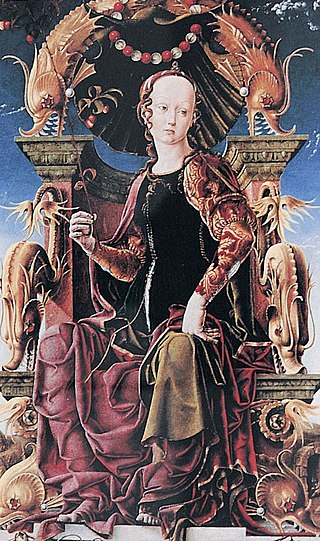
Cosmê Tura, also known as Il Cosmè or Cosimo Tura, was an Italian early-Renaissance painter and considered one of the founders of the School of Ferrara.

Joos van Cleve was a leading painter active in Antwerp from his arrival there around 1511 until his death in 1540 or 1541. Within Dutch and Flemish Renaissance painting, he combines the traditional techniques of Early Netherlandish painting with influences of more contemporary Renaissance painting styles.

The St John Altarpiece is a large oil-on-oak hinged-triptych altarpiece completed around 1479 by the Early Netherlandish master painter Hans Memling. It was commissioned in the mid-1470s in Bruges for the Old St. John's Hospital (Sint-Janshospitaal) during the building of a new apse. It is signed and dated 1479 on the original frame – its date of installation – and is today still at the hospital in the Memling museum.

The Cloisters Apocalypse, MS 68.174 is a small French illuminated manuscript dated c. 1330. It is based on John the Evangelist's New Testament visions and apocalyptic revelation. According to Christian legend John was exiled c. 95 CE to the Aegean island of Patmos, where he wrote the Book of Revelation. The book evokes John's despair and isolation while exiled, and his prophecy of events and terrors of the last days.

Landscape Near Beauvais is an oil-on-canvas painting by François Boucher, dated to the 1740s and now in the Hermitage Museum in St Petersburg.

Landscape with Saint John on Patmos is a 1640 neoclassical painting by Nicolas Poussin, now in the Art Institute of Chicago. The painting features Saint John, banished to Patmos, writing the Book of Revelation amidst a classical landscape background.

La Boudeuse is the modern title given to an oil on canvas painting in the Hermitage Museum, Saint Petersburg, by the French Rococo painter Antoine Watteau (1684–1721). Completed in the late 1710s, La Boudeuse depicts a young couple set amidst a park in the foreground, in a rare example of the two-figure landscape composition which is considered one of the best fêtes galantes in Watteau's later work. However, the picture's authenticity was also a subject of scholarly debate, for it had been engraved by English painter Philippe Mercier, once a follower of Watteau, and was not included in Jean de Jullienne's edition of Watteau's work published in the 1730s.
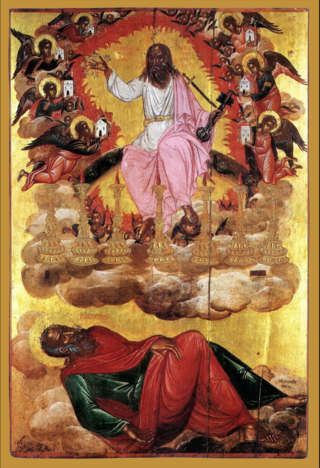
Vision of the ApocalypseApocalypse, also known as The Revelation of John the Evangelist, is a tempera painting by Thomas Bathas. The massive icon is over four hundred years old. Bathas was from the island of Crete. He was a painter active during the second half of the 16th century. He was active in Heraklion, Venice, and Corfu. He was an important member of the Cretan School. The painting follows the traditional maniera greca. The magnificent icon is on the Greek island of Patmos inside the Cave of the Apocalypse. The mysterious site is believed by Christians to mark the spot where John of Patmos received his visions that he recorded in the Book of Revelation.
